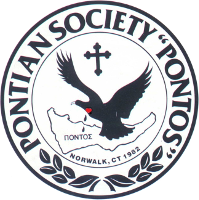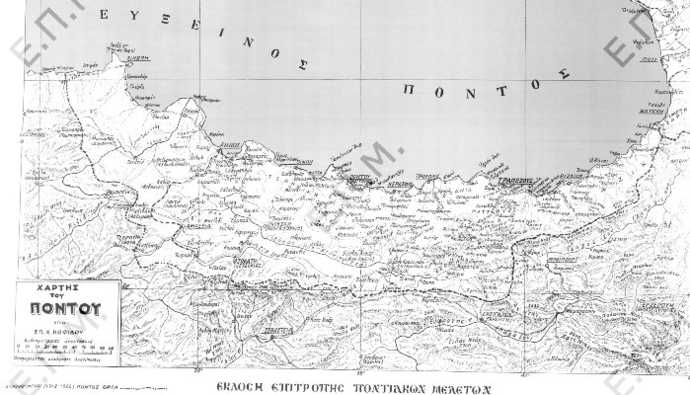Name, area, population.
The coastal section of the NE is called Pontos. Central Asia, which stretches from the region of Sinope to the eastern tip of the Black Sea (Batumi), in an area of 71,500 square kilometers with 2,048,250 inhabitants at that time, of whom 697,000 were Greek Orthodox Christians.
Other geographical data.
a) Mountains.
At a distance of about 100 km to the south from the beach and throughout the Pontus from west to east extends the Paryardis mountain range (Giavour dag), which separates the Pontus from the rest of South Asia Minor with only two main communication passages , one from Amisos to Sebastia and the hinterland and the other from Trabzon to Erzurum and the East. The main branches of this mountain range from the West are: the Kemer Dag mountain in the North of Amasya, Gildiz Dag North of Sevasti, Karadag north of Nikopolis, Kemer Dag East of Argyroupoli, etc.
b) Rivers.
The main rivers that flow into the Black Sea from west to east are the Alys (Kizil Irmak), the largest river in Central Asia that separates the Pontus from Paphlagonia, and then the Iris (Gesil Irmak) which crosses Amaseia and joins the Lykos River (Kelkit), while to the east we have Harsiotis and Pyxitis, which flow first near Tripoli and the second near Trabzon, finally towards the border with Russia we have the Akampsi (Tsorouch sou) which flows near Batumi.
Demographics.
a) Cities.
The main cities of Pontus are: Trabzon with 50,000 inhabitants then, of which 15,000 Greeks, Kerasounta with 20,000 inhabitants, of which 12,000 Greeks, Tripoli with 10,000, of which 3,000 Greeks, Kotyora (Ordou) with 12,000 , of which 6,000 Greeks, Amisos (Samsun) with 35,000, of which 18,000 Greeks, Sinopi with 15,000, of which 4,500 Greeks, Nikopolis with 1,500 Greeks, Argyroupoli with 6,000 inhabitants, of which 2,500 Greeks and Amaseia with 42,000, of which 18,000 Greeks.
b) Ecclesiastical situation – Education.
Pontus was divided into 6 metropolis:
1. the metropolis of Trabzon with 84 schools, 165 teachers and 6,800 students,
2. the metropolis of Rodopolis with 55 schools, 87 teachers and 3,053 students,
3. the metropolis of Cologne with 88 schools, 94 teachers and 4,900 students,
4. the metropolis of Chaldia – Kerasounta with 252 schools, 322 teachers and 24,800 students,
5. the metropolis of Neocaesarea with 182 schools, 193 teachers and 12,800 students and
6. the metropolis of Amaseia with 376 schools, 386 teachers and 23,600 students.
In general, there were 1,047 schools throughout Pontus with 1,247 teachers and 75,953 students. Among the schools, the Trebizond Tutoring Center was famous, a real beacon of education with a huge amount of radiation, as well as the Argyroupoli Tutoring Center, the Goumera High School, the Kerasountas Half High School, the Amisos High School, etc. Clergy of that time were famous for the preservation and cultivation of religious thought and education the monasteries: Panagia Soumela, Panagia Goumera, Agios Georgios Peristereotas, Agios Ioannis of Vazelonos etc.
 Historical data.
Historical data.
Although the history of Pontus goes back in the depths of the centuries with the Argonaut campaign and the first settlements of the Greeks in these places immediately after the Trojan War (1100 BC), its very history is evident from the beginning of the 8th century BC with the founding of Sinope by Milesian settlers in 785 BC, and later of other cities: Trabzon (756 BC), Kerasounta (700 BC), Amisos (Samsun 600 BC), Kotyoron (Ordou), Tripoli, etc. Throughout its long life (1100 BC -1922 AD), a period of 3,000 years, Pontus was one of the most important parts of the Greek nation, in which the Hellenism of this region both in the years of antiquity and Alexander the Great and Roman Empire and Byzantium and this Ottoman Empire (1461-1922) did not cease to keep intact his national conscience and prosperous and proud of his national mind with unshakable faith in his indestructible ancestral traditions.
 After the end of the First World War (1914-1918) and the declaration of the victors, regarding the self-determination of the peoples, prominent personalities of the Greek Pontians conceived the idea of creating an Independent Republic of Pontus with memos and representations to the representatives of the Great and a map of the “claimed Pontus”, for the convenience of the allies. Unfortunately, this dream did not come true mainly due to the reaction of the Great Powers.
After the end of the First World War (1914-1918) and the declaration of the victors, regarding the self-determination of the peoples, prominent personalities of the Greek Pontians conceived the idea of creating an Independent Republic of Pontus with memos and representations to the representatives of the Great and a map of the “claimed Pontus”, for the convenience of the allies. Unfortunately, this dream did not come true mainly due to the reaction of the Great Powers.
Persecution-Genocide.
From the outbreak of the First World War (1914) to the Asia Minor catastrophe (1922), the Neo-Turks with the harsh measures they took against the Greeks of Pontus by the method of exile, rape, massacre, extermination and hanging (according to Panaretos Topalidis) exterminated:
a. during the period 1914-1918 170,576 Greek Pontians
b. during the period 1918-1922 119,122 Greek Pontians
that is, a total of 289,698 Greek Pontians, a percentage of 41.56% in a total of 697,000 Greek Pontians, while according to G. Valavanis, the losses of the Greek Pontians according to the Black Book of the Central Council of Pontians in Athens amounted to 303,238 by 1922, and 353,000 as March 1924, a percentage that exceeds 50% of the total population of the Greeks of Pontus.

